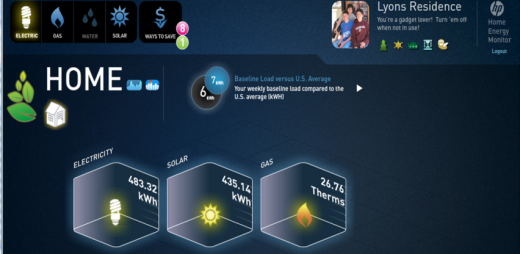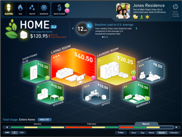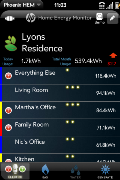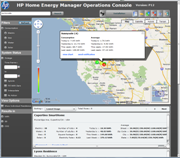Building the Energy-Smart Home
HP Labs creates the HP Home Energy Manager to demonstrate how it could happen
By Simon Firth
Homes are a prime opportunity to improve energy management. In a pilot project, HP Labs has deployed sensing technology and a cloud-based application that provides unprecedented visibility and insight into a home’s energy use. Through an intuitive, customizable dashboard, homeowners can monitor and manage energy consumption of everything from their dishwasher to their TV, and learn how to save power in a room or throughout their entire house. By making home energy management easy and fun, HP is helping consumers make choices and change behaviors to save energy and money.
"Energy awareness in the home is about to undergo a transformation," says Martha Lyons, a project manager with HP Labs’ Sustainable Ecosystems Research Group.
"We’re already seeing SmartMeters being installed in homes," she notes, "and they will enable the creation of services that help people better understand, and as a result reduce, their energy consumption."
To that end, a team led by Lyons spent the last year developing the HP Labs Home Energy Manager, a proof of concept for just such a service. Our research in home energy management gives individual awareness into their home’s energy use by monitoring everything from the dishwasher to the TV.
The project deployed sensors in seven residential homes around California that measured the energy consumption of individual appliances and "activity zones" within each house. An HP server in the homes received readings from these sensors every 3 seconds, which it then sent to the cloud in an aggregated data set every 2 minutes. Over 20 million sensor readings were collected in all.
Those data were analyzed in real time to produce messages displayed back in the home, offering recommendations the homeowners could act upon easily – such as shifting usage to optimize costs, or not leaving the TV on overnight.
Energy consumption information at a glance
While the team was able to use commercially-available sensors, they built almost every other part of the service from scratch. Of particular note, says Lyons, was software that let them take readings from a specific power strip and figure the energy consumption of multiple devices plugged into it.
"So if you had a DVR, a TV, a PC and an Xbox all running off one strip," she explains, "we were able to build a model of when the appliances were going on and off and then break out the energy consumption for each."
This disaggregation was performed on a purpose-built, cloud-based server, and then relayed back to the owners of each home via a novel user interface that visualized their specific patterns of use.
Rather than display historical data in graphs and pie charts, says Lyons, the team opted to foreground how much power the different devices and zones within the house were consuming and to alert users to any unusual activity. Home owners might, for example, see that a new appliance had increased or lessened their overall consumption. The interface could also issue alerts when specific appliances were behaving abnormally. Indeed, one participant found out he needed a new fridge as a result of using the service. Another discovered that she was wasting a lot of energy by leaving appliances running long into the night.
"We wanted to create an experience that conveyed information at a glance," Lyons adds. "If you do that, you make it easy for consumers to not just be informed, but also be engaged and motivated to optimize their energy consumption."
A system with a holistic view and the potential for social incentives
While SmartMeters can accurately monitor a home’s total power consumption over time, a more granular approach both empowers and encourages its owners to take actions that can have a real impact, the HP team believes.
As implemented, the prototype HP service measured electricity use as well as room temperatures and, in some cases, the energy produced by solar power installations. But it wouldn’t be hard to add other measures such as water and natural gas consumption, Lyons says.
"When you get this kind of holistic view," she suggests, "things get interesting. People don’t really understand if they should do their dishes by hand or use the dishwasher, for example. This could help them answer those questions better."
"This kind of service also lends itself to the world of competitive social incentives and reputation building," adds Lyons. "For example, you could earn a badge based on validated behavioral change that says you’ve reduced your energy consumption by 20%, say, that you could display on a site like Facebook. That’s also likely to increase the chance that you’ll act on the specific, appliance-level advice that we’re able to give you."
The increasing importance of energy consumption management
In the near term, the HP researchers envision several kinds of consumers being interested in a service like the HP Home Energy Manager: the budget conscious, for example, as well as environmentally conscious customers and early-adopting gadget lovers who enjoy being the first to try out new technologies.
It’s likely, however, that ever-rising fuel prices will keep utility rates climbing. If that happens, reducing consumption is liable to become a priority for a substantial majority of utility customers.
Such a scenario would also likely see utilities increasing their use of differential pricing – where they charge a premium for power used in periods of peak demand. In that case, says Lyons, a system-wide installation of a service like the HP Home Manager would let utilities offer their customers both clear information and powerful incentives to run power-hungry appliances at specific times.
Even today, she notes, "there are limits to how much electricity utilities can produce and transmit. And demand is only increasing. How we manage that capacity, and the efficiency with which we manage it, is going to be increasingly important."
Monitoring energy usage from a single house to an entire city
Developed in collaboration with HP’s Corporate Sustainability team and its Enterprise Services Utilities group, the HP Home Energy Manager is one of the first projects to be developed under HP Labs’ new Demonstrator Initiative.
"The idea is to take an area of your research and show how it could be used in a full, real life context," says Lyons. "From that you learn a lot, and then you take the most promising insights and use them to direct your next set of research topics."
For the Home Energy Manager team, those topics include further refining the home-based model and moving from systems that offer feedback on a single, relatively small house to ones that address larger buildings, campuses and eventually entire communities.
"This supports our group’s vision of what we’re calling the City 2.0," says Lyons. "We’re also adding what we’ve learned from the dynamic provisioning of power and cooling in the data center over the past few years. That, combined with the analytics that we’ve been developing for the Home Energy Manager, will allow us to begin scaling up to the level of being able to monitor, and thus better manage, energy supply and demand for the whole ecosystem."
The HP Home Energy Manager project was showcased last month at the launch of HP’s global Unlocking Your Energy initiative and has already generated interest both within HP and among major utility and telecommunications businesses.
"We now live in a world made up of "Smart Things"– smart meters, smart plugs, appliances, electric cars and so on," noted senior fellow Chandrakant Patel, the originator of the City 2.0 concept and director of HP’s Sustainable Ecosystems Research Group, at the launch. "That offers us a great opportunity to monitor, analyze, and control energy usage for everything from a house up, eventually, to an entire city."


